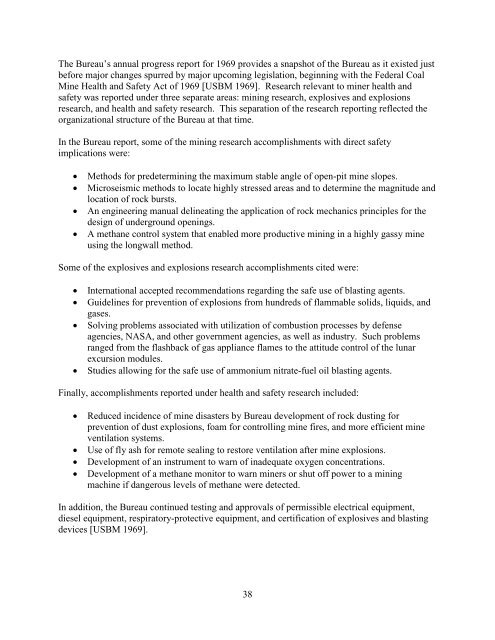One Hundred Years of Federal Mining Safety and Health Research
One Hundred Years of Federal Mining Safety and Health Research
One Hundred Years of Federal Mining Safety and Health Research
- No tags were found...
You also want an ePaper? Increase the reach of your titles
YUMPU automatically turns print PDFs into web optimized ePapers that Google loves.
The Bureau’s annual progress report for 1969 provides a snapshot <strong>of</strong> the Bureau as it existed just<br />
before major changes spurred by major upcoming legislation, beginning with the <strong>Federal</strong> Coal<br />
Mine <strong>Health</strong> <strong>and</strong> <strong>Safety</strong> Act <strong>of</strong> 1969 [USBM 1969]. <strong>Research</strong> relevant to miner health <strong>and</strong><br />
safety was reported under three separate areas: mining research, explosives <strong>and</strong> explosions<br />
research, <strong>and</strong> health <strong>and</strong> safety research. This separation <strong>of</strong> the research reporting reflected the<br />
organizational structure <strong>of</strong> the Bureau at that time.<br />
In the Bureau report, some <strong>of</strong> the mining research accomplishments with direct safety<br />
implications were:<br />
• Methods for predetermining the maximum stable angle <strong>of</strong> open-pit mine slopes.<br />
• Microseismic methods to locate highly stressed areas <strong>and</strong> to determine the magnitude <strong>and</strong><br />
location <strong>of</strong> rock bursts.<br />
• An engineering manual delineating the application <strong>of</strong> rock mechanics principles for the<br />
design <strong>of</strong> underground openings.<br />
• A methane control system that enabled more productive mining in a highly gassy mine<br />
using the longwall method.<br />
Some <strong>of</strong> the explosives <strong>and</strong> explosions research accomplishments cited were:<br />
• International accepted recommendations regarding the safe use <strong>of</strong> blasting agents.<br />
• Guidelines for prevention <strong>of</strong> explosions from hundreds <strong>of</strong> flammable solids, liquids, <strong>and</strong><br />
gases.<br />
• Solving problems associated with utilization <strong>of</strong> combustion processes by defense<br />
agencies, NASA, <strong>and</strong> other government agencies, as well as industry. Such problems<br />
ranged from the flashback <strong>of</strong> gas appliance flames to the attitude control <strong>of</strong> the lunar<br />
excursion modules.<br />
• Studies allowing for the safe use <strong>of</strong> ammonium nitrate-fuel oil blasting agents.<br />
Finally, accomplishments reported under health <strong>and</strong> safety research included:<br />
• Reduced incidence <strong>of</strong> mine disasters by Bureau development <strong>of</strong> rock dusting for<br />
prevention <strong>of</strong> dust explosions, foam for controlling mine fires, <strong>and</strong> more efficient mine<br />
ventilation systems.<br />
• Use <strong>of</strong> fly ash for remote sealing to restore ventilation after mine explosions.<br />
• Development <strong>of</strong> an instrument to warn <strong>of</strong> inadequate oxygen concentrations.<br />
• Development <strong>of</strong> a methane monitor to warn miners or shut <strong>of</strong>f power to a mining<br />
machine if dangerous levels <strong>of</strong> methane were detected.<br />
In addition, the Bureau continued testing <strong>and</strong> approvals <strong>of</strong> permissible electrical equipment,<br />
diesel equipment, respiratory-protective equipment, <strong>and</strong> certification <strong>of</strong> explosives <strong>and</strong> blasting<br />
devices [USBM 1969].<br />
38
















